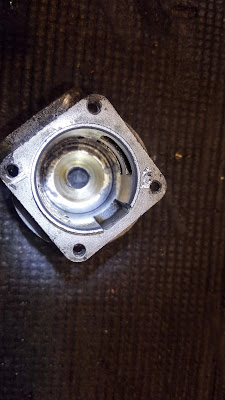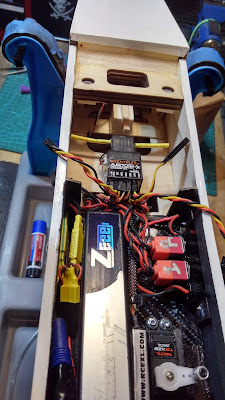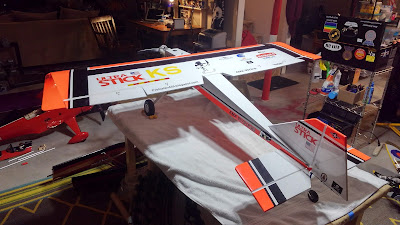Dark, heavy, but high clouds threatened rain, but the drought made this unlikely, a coy deception. Pretty much windless, and a comfortable mid 60s temps, I had been itching, and Saturday afternoon was time to scratch!
The flying monkeys got me...
Monday, October 26, 2020
Finally, a flying day!
Sunday, October 25, 2020
Its Baaack... The servo twitch curse.
The Ugly Stik had this aileron twitch I could not get rid of... it eventually lead to the loss of the Stik. I guess I haven't fired up the Ultra Stik with the wing on, because I would have noticed this twitch curse has come to the new plane. I had her out at the field and set her up, excited to maiden her, even drove her around to range test her, but I noticed that at idle and WOT the twitch showed up, curiously not in midrange. The video doesn't capture the worst of it, it would occasionally go full deflection. The only parts that are the same are the Hitec HS-485HB servos, except for the elevator which is new. Odd, the left aileron is again affected, and the elevator! The connections are all solid but will get a second look. These are usually voltage issues.
1. A capacitor. The theory here is that the twitch is from voltage spikes and drops, and the milliamps stored in the capacitor acts to buffer this letting those variations come from the capacitor per se, and not the reciever. This plugs into a spare port on the reciever. I am not sure they work, and people seem to find them controversial as to their effectiveness or need for that matter. This one from Amazon for $8 delivered (had a coupon, cost me $3).
2. Tech-Aero Ultra IBEC. This is what I prefer to the simple RCexl remote opto switch. The optical switch is supposed to isolate the electrical noise from the ignition and keep it out of the reciever by using a optical interrupt (the electrical signal gets turned into an optical (photon) signal, back to electrical, with that light isolating the two sides from on another, or something like that). It runs about $17. The Ultra IBEC instead filters the signal 4 times through various capacitors and then stabilizes the power to remove any noise. I honestly don't know if these have any functional differences otherwise. They both could be replaced from a noise cleanup standpoint, by using a ignition only battery. Clearly if this is an ignition noise issue the RCexel switch is not stopping it. Since I think it would, if the IBEC instead works, then its a voltage stabilizing issue that the capacitor could not solve.
3. Change the servos. People knock "budget" servos, but honestly the only difference I have seen is initial quality. If they work out of the bag/box, they work fine, but yeah there are some junk brands out there so you have to know what you are buying. Reviews show these to be very reliable and I get 4 metal gear digital servos for a great price, $18 for 4. I have never had one that failed, even out of the bag. Someday when I can drop $150 on 4 name brand servos I may change them, but right now, this is the way to go.
Wednesday, October 14, 2020
New Aircraft are ready to Maiden!
Sunday, October 11, 2020
Lit the fires on the Ultra Stick
No pics today, but I got the Ultra Stick out to the back on the test table and ran her up. Started right away, needed a little tuning. Produce 5.2 lbs of thrust with the 13x8x3. Then the uncollapsable table leg collapsed in front and she dropped on the prop still attached to the fallen front of the table. I was a bit pissed so didn't take any pics.
The engine ran ok, but was really slow to run up, and thenreally slow to come back down. I leaned it out I the low end and she is running pretty well. I was pretty much finished when the end of the table collapsed,.
The elevator servo went rogue. I suspect this is the bad one that killed the Ugly Stick? The tests could not find it, but it went really jittery and then locked up, already ordered a replacement.
I think once ai replace the servo she is ready to maiden!
Wednesday, October 7, 2020
Yikes, a 9-1/2 lb baby...
The Bad Cylinder Revisited
Sunday, October 4, 2020
Hangar 9 10CC Ultra Stick Completed!
The Hangar 9 Ultra Stick 10 cc project is done, and it was some kind of journey. I've not had a build shift course so many times. Its not where I was going, but its where I intended it to be.



















































